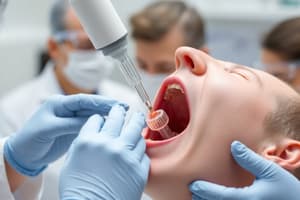Podcast
Questions and Answers
What type of agar plate is primarily used for throat cultures, and what is its unique component?
What type of agar plate is primarily used for throat cultures, and what is its unique component?
Blood agar plate, which contains 5% sheep's blood.
Describe the difference in hemolysis observed for A-hemolytic and B-hemolytic streptococci.
Describe the difference in hemolysis observed for A-hemolytic and B-hemolytic streptococci.
A-hemolytic gives a greenish color due to partial breakdown of RBCs, while B-hemolytic results in clear zones from complete breakdown.
What procedure is necessary to collect a urine sample for a UTI culture, and why is this important?
What procedure is necessary to collect a urine sample for a UTI culture, and why is this important?
A 'clean catch' method is needed, which ensures minimal contamination during urine collection.
At what bacterial count is a urine culture considered significant for diagnosing a UTI?
At what bacterial count is a urine culture considered significant for diagnosing a UTI?
What is the purpose of using the GasPak system when culturing anaerobic pathogens?
What is the purpose of using the GasPak system when culturing anaerobic pathogens?
Define the role of biological vectors in disease transmission.
Define the role of biological vectors in disease transmission.
What distinguishes facultative pathogens from obligate anaerobes?
What distinguishes facultative pathogens from obligate anaerobes?
What should be done with urine samples after collection to prevent inaccurate results?
What should be done with urine samples after collection to prevent inaccurate results?
In terms of hemolysis, how would you characterize Y-hemolytic streptococci?
In terms of hemolysis, how would you characterize Y-hemolytic streptococci?
What are the two types of vectors mentioned, and how do they differ?
What are the two types of vectors mentioned, and how do they differ?
Flashcards
Hemolysis Types
Hemolysis Types
Different ways bacteria affect red blood cells (RBCs) on blood agar plates.
UTI Diagnosis
UTI Diagnosis
Determining a urinary tract infection (UTI) based on the amount of bacteria in a urine sample.
Urine Culture Steps
Urine Culture Steps
Steps to collect and test urine specimens for UTI: Clean catch, sterile container, inoculation, and incubation of plates.
Obligate Anaerobes
Obligate Anaerobes
Signup and view all the flashcards
GasPak System
GasPak System
Signup and view all the flashcards
Mechanical Vectors
Mechanical Vectors
Signup and view all the flashcards
Blood Agar
Blood Agar
Signup and view all the flashcards
Aerobic Pathogens
Aerobic Pathogens
Signup and view all the flashcards
Biological Vectors
Biological Vectors
Signup and view all the flashcards
Eosin Methylene Blue(EMB) Plate
Eosin Methylene Blue(EMB) Plate
Signup and view all the flashcards
Study Notes
Throat Cultures
- Bacteria feed on blood iron.
- Blood agar plates are used, containing 5% sheep's blood.
- Alpha-hemolysis: Partial breakdown of red blood cells (RBCs), producing greenish discoloration. Example: Streptococcus pneumoniae.
- Beta-hemolysis: Complete breakdown of RBCs, creating clear zones around colonies. Example: Streptococcus pyogenes.
- Gamma-hemolysis: No breakdown of RBCs; no color change.
Urine Cultures
- Diagnose Urinary Tract Infections (UTIs), most commonly caused by E. coli.
- Uses Eosin Methylene Blue (EMB) and Blood agar (BA) plates.
- Collection: Urine collected in a sterile container; wipe the area before urination, using a "clean catch" method (mid-stream).
- Sterility: Urine is normally sterile in the body but becomes contaminated as it leaves.
- Significant bacteriuria: 100,000/mL of a particular organism indicates a significant infection.
- E. coli prevalence: Frequent cause of UTI due to its presence in the intestinal tract and proximity to the urethra.
- Testing: Samples must be tested or refrigerated immediately to prevent rapid growth and inaccurate results.
- Procedure:
- Collect urine in a sterile container.
- Inoculate the urine onto both EMB and BA plates using a cotton swab.
- Incubate at 37°C for 48 hours.
Anaerobic Pathogens
- TSA plates: Used for culturing on Tryptic Soy Agar plates.
- Aerobes: Need oxygen to grow.
- Obligate anaerobes: Do not require oxygen to grow; these types are more difficult to grow.
- GasPak System: Used to create an anaerobic environment. Plates are placed in a jar with a sachet that removes oxygen, sealed tightly.
- Facultative anaerobes: Grow with or without oxygen.
- Procedure:
- Inoculate a plate with a loop of bacteria.
- Use the GasPak system.
- Place plate in a jar with sachet and a methylene blue strip, then seal. The methylene blue strip turns white when no air is present.
Vectors
- Vectors: Organisms that transmit disease-causing microbes.
- Transmission: Via food/water, respiratory droplets, sexual contact.
- Types of Vectors:
- Human vectors: Insects (e.g., flies, mosquitoes, ticks, mites).
- Mechanical vectors: Carry microbes on their bodies (e.g., a fly landing on food).
- Biological vectors: Carry microbes within their bodies (e.g., a mosquito biting and transmitting malaria).
- Control/eradication difficulty: Vector-borne pathogens are difficult to control because of the necessity to kill all microbes.
- Control methods: Insecticides and insect repellents.
Studying That Suits You
Use AI to generate personalized quizzes and flashcards to suit your learning preferences.



